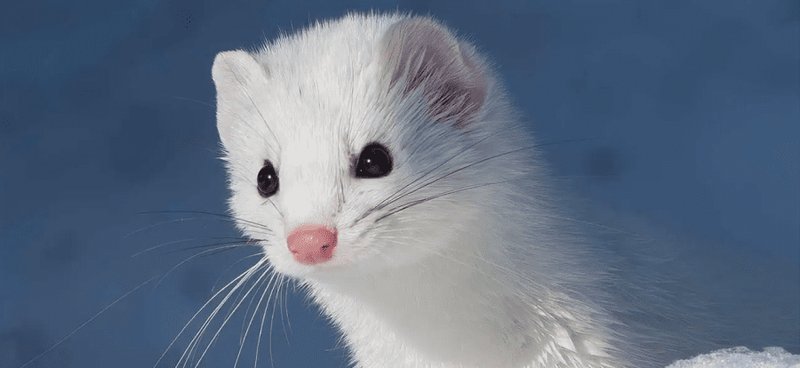
Imagine for a moment that you’re at the local park, watching a tiny creature darting through the underbrush. That’s an ermine, and it’s not just racing around aimlessly. It’s using its sharp brain to navigate its environment, find food, and avoid predators. So, how smart really is this little animal? Let’s explore this topic together over a virtual cup of coffee.
Understanding the Ermine: A Quick Overview
Ermines, also known as stoats, are small carnivorous mammals belonging to the weasel family. These creatures are known for their distinct seasonal color changes—from a rich brown in summer to a striking white in winter. This change not only helps them blend into their surroundings but also showcases a clever adaptation strategy. Living in various habitats, including forests, fields, and even snowy terrains, they have developed remarkable survival skills.
One fascinating thing about ermines is how they rely on their physical and cognitive skills to thrive. They can measure around 12 inches long and weigh only a few ounces, yet their intelligence packs a punch. They’re highly adaptable hunters, making them effective at catching prey, which usually consists of small rabbits, birds, and rodents.
Cognitive Abilities: What Makes Ermines So Smart?
So, you might be wondering, what exactly makes ermines clever? When we talk about animal intelligence, we often consider problem-solving skills, memory, and adaptability to various situations. Ermines possess a keen sense of awareness about their environment, which is a significant aspect of their cognitive abilities.
These little creatures have excellent hunting instincts. They can strategize when approaching prey, using stealth and patience. For instance, they often pounce from a hidden spot to surprise their target. This type of hunting technique showcases not just instinct but also learned behavior. Young ermines learn from their parents, picking up valuable lessons on how to navigate their world effectively.
Moreover, their memory plays a crucial role in their intelligence. They’re capable of remembering the locations of their burrows and where to find food sources, which is vital for survival in the wild. In many ways, ermines remind us of tiny furry engineers, constructing clever strategies to secure their meals.
Social Behavior: The Ermine’s Communication Skills
Ermines are typically solitary creatures, but that doesn’t mean they lack social skills. One interesting aspect of their behavior is their communication with one another, particularly during mating season. They use vocalizations, body language, and scent marking to convey information about territory and readiness to mate.
For example, males might engage in vocal calls that attract females, while females can demonstrate specific movements to signal their interest. This communication is crucial for their reproductive success and demonstrates another layer of their cognitive abilities.
In addition, they show a level of territorial behavior. By marking their territory with scent, they communicate boundaries to other ermines, reducing conflicts and ensuring they have enough space to hunt and thrive.
Learning and Adaptation: Survival Skills in the Wild
Ermines exhibit a remarkable ability to learn from their environment. They adapt quickly to changes in their surroundings, whether it’s a new predator in the area or a scarce food supply. This adaptability is a testament to their intelligence.
If an ermine finds that a specific hunting area isn’t producing enough food, it will explore new territories. They’re not just wandering aimlessly; they’re problem-solvers on a mission. This flexibility ensures their survival and showcases a high level of cognitive functioning.
Furthermore, they learn how to navigate obstacles in their path. When hunting or escaping threats, they can figure out the best routes to take, which isn’t just instinctual but also indicates an understanding of their environment.
Comparing Ermines to Other Small Mammals
When you think about intelligence in small mammals, ermines often compete with other species like squirrels and rabbits. But how do they stack up? Let’s take a look.
- Problem Solving: Squirrels are known for their ability to navigate complex environments, especially when it comes to finding food. However, ermines show a higher level of stealth and strategy when hunting.
- Memory: Both ermines and rabbits have strong memories for locating resources. Rabbits might remember food sources but often remain in one area, while ermines actively seek alternative sites as needed.
- Social Behavior: Unlike rabbits, which can be social and live in groups, ermines prefer solitude, showcasing individuality in their behaviors and strategies.
In this comparison, while other small mammals exhibit their unique skills, ermines stand out for their combination of stealth, adaptability, and hunting prowess.
Conservation and Understanding Ermine Behavior
Understanding ermine behavior is essential for conservation efforts. As their habitats face threats from climate change and human activity, knowing how these animals think and adapt can help in creating effective strategies to protect them.
Conservationists focus on preserving their natural habitats, ensuring that ermines have safe places to live and hunt. Additionally, educating people about their behavior and intelligence helps foster respect for these creatures. The more we understand them, the better we can advocate for their protection.
Researchers also study ermine behaviors to learn more about animal intelligence in general. By observing how they interact with the environment and other species, we can gain insights into the evolution of cognition across different species.
Ermines may be small, but their cognitive abilities and behaviors are nothing short of impressive. From their problem-solving skills to their adaptability, they showcase a remarkable level of intelligence that often goes unnoticed. Understanding how smart these creatures are can deepen our appreciation for wildlife and reinforce the importance of conserving their habitats.
So, the next time you see an ermine gliding through the grass or darting after prey, remember—it’s not just another cute animal. This clever little creature is a master of survival, using its brain as much as its instincts. And that’s something worth celebrating.
